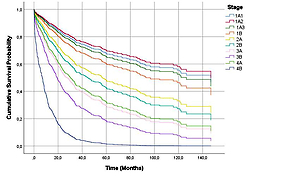Current issue
Archive
Manuscripts accepted
About the Journal
Editorial office
Editorial board
Abstracting and indexing
Subscription
Contact
Ethical standards and procedures
Most read articles
Instructions for authors
Article Processing Charge (APC)
Regulations of paying article processing charge (APC)
ONCOLOGY / RESEARCH PAPER
The Relationship between Preoperative FDG PET/CT Uptake and Survival in Patients with Lung Cancer
1
Gaziantep University, Turkey
Submission date: 2022-03-14
Final revision date: 2022-05-21
Acceptance date: 2022-06-06
Online publication date: 2022-06-12
KEYWORDS
TOPICS
ABSTRACT
Introduction:
Despite all advances in diagnosis and treatment, lung cancer is the leading cause of cancer death in both sexes worldwide. Because of the different survival rates in lung cancer, additional factors are needed to determine prognosis. In this study, we aimed to investigate the relationship between survival and clinical data of primary tumor SUV (Standardized Uptake Value) to evaluate the role of FDG-PET ([18F]-fluoro-2-deoxy-D-glucose Positron Emission Tomography) as a prognostic factor in lung cancer.
Material and methods:
The data of patients who underwent anatomic resection and preoperative positron emission tomography/computed tomography (PET/CT) were performed retrospectively between February 2006 and October 2019 in the Department of Thoracic Surgery, Faculty of Medicine, Gaziantep University.
Results:
All cases were 666 patients, 64 of whom (9.6%) were females and 602 of them (90.4%) were males. The mean age of the patients was 61.91±9.6 years. Histologically, there were 369 (55.4%) epidermoid carcinomas, 233 (34.9%) adenocarcinomas. The overall mean survival was 68.2 months and the median survival was 63.6 months. The mean mass SUV values of the patients were 13.73 ± 6.65. The effect of histological type, TNM stage, metastasis and recurrence on survival was statistically significant (p < 0.05). According to the univariate analysis (Cox regression analysis), it was found that 1 unit increase in SUV value contributed to a statistically significant increase in mortality risk (p = 0.002, HR: 1.024, 95% CI: 1.009-1.040).
Conclusions:
In our study on 666 patients, unlike literature, no statistically significant relationship was found between SUV value and survival.
Despite all advances in diagnosis and treatment, lung cancer is the leading cause of cancer death in both sexes worldwide. Because of the different survival rates in lung cancer, additional factors are needed to determine prognosis. In this study, we aimed to investigate the relationship between survival and clinical data of primary tumor SUV (Standardized Uptake Value) to evaluate the role of FDG-PET ([18F]-fluoro-2-deoxy-D-glucose Positron Emission Tomography) as a prognostic factor in lung cancer.
Material and methods:
The data of patients who underwent anatomic resection and preoperative positron emission tomography/computed tomography (PET/CT) were performed retrospectively between February 2006 and October 2019 in the Department of Thoracic Surgery, Faculty of Medicine, Gaziantep University.
Results:
All cases were 666 patients, 64 of whom (9.6%) were females and 602 of them (90.4%) were males. The mean age of the patients was 61.91±9.6 years. Histologically, there were 369 (55.4%) epidermoid carcinomas, 233 (34.9%) adenocarcinomas. The overall mean survival was 68.2 months and the median survival was 63.6 months. The mean mass SUV values of the patients were 13.73 ± 6.65. The effect of histological type, TNM stage, metastasis and recurrence on survival was statistically significant (p < 0.05). According to the univariate analysis (Cox regression analysis), it was found that 1 unit increase in SUV value contributed to a statistically significant increase in mortality risk (p = 0.002, HR: 1.024, 95% CI: 1.009-1.040).
Conclusions:
In our study on 666 patients, unlike literature, no statistically significant relationship was found between SUV value and survival.
We process personal data collected when visiting the website. The function of obtaining information about users and their behavior is carried out by voluntarily entered information in forms and saving cookies in end devices. Data, including cookies, are used to provide services, improve the user experience and to analyze the traffic in accordance with the Privacy policy. Data are also collected and processed by Google Analytics tool (more).
You can change cookies settings in your browser. Restricted use of cookies in the browser configuration may affect some functionalities of the website.
You can change cookies settings in your browser. Restricted use of cookies in the browser configuration may affect some functionalities of the website.



